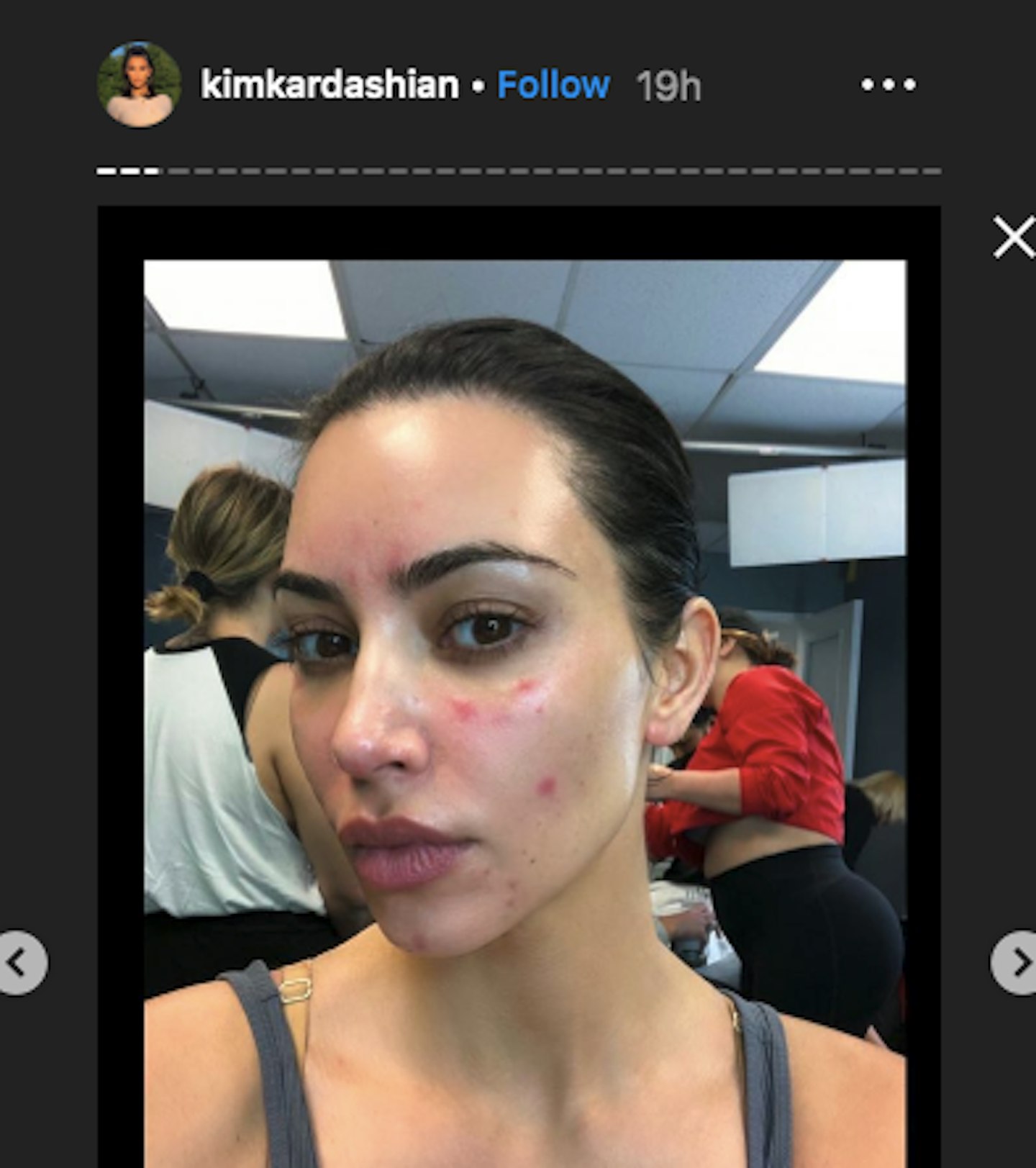Kim Kardashian has opened up about her journey with psoriasis for Kourtney Kardashian’s lifestyle website, Poosh{
‘Even though I always grew up with my mom having psoriasis and hearing her talk about her struggle, I really had no idea what my life would be like dealing with an autoimmune disease myself,’ she explains in the piece.
What is psoriasis?
Going on to discuss her 13-year journey with the skin condition, she stated it initially flared up at age 25 after a common cold triggered the auto-immune disease. While psoriasis can run in families, the exact role genetics play in causing the condition is unclear, according to the NHS. In the UK it is estimated to impact up to 2.2% of the population – up to 3% worldwide.
So what causes psoriasis?
‘People with psoriasis have an increased production of skin cells,’ the NHS website explains, ‘Skin cells are normally made and replaced every 3 to 4 weeks, but in psoriasis this process only takes about 3 to 7 days. The resulting build-up of skin cells is what creates the patches associated with psoriasis.
‘Although the process is not fully understood, it's thought to be related to a problem with the immune system,’ the explanation concludes, ‘The immune system is your body's defence against disease and infection, but it attacks healthy skin cells by mistake in people with psoriasis.’
According to the NHS, possible triggers of psoriasis include ‘injury to your skin, throat infections and using certain medicines.’
However, it warns that ‘the condition is not contagious, so it cannot be spread from person to person.’
How did Kim Kardashian manage living with psoriasis?

‘My neighbour was a dermatologist,’ Kim explains dealing with her first flare-up, ‘I showed it to him, and he said to come into the office and he would give me a shot of cortisone and then hopefully it would go away (since it was my first big outbreak). I did this and my psoriasis completely went away for about five years.
‘However, it came back again in my early thirties,’ she continued.
Detailing the next eight years of her life with psoriasis, Kim says that her spots are always unpredictable apart from one main flare-up on her right leg. While she says it doesn’t bother her anymore, she describes covering up the spots with body makeup to avoid them being a ‘distraction’.
‘When I got pregnant both times, it fully went away,’ she shares, ‘That was amazing, but then it came back again. Earlier this year is when it got extremely bad—it covered my whole face and a majority of my entire body.’
What is psoriatic arthritis?
For Kim, her psoriasis eventually developed into psoriatic arthritis. A long-term condition that can worsen in time, it causes inflamed, stiff and painful joints.
‘One night, I woke up to use the restroom and I physically couldn’t pick up my phone,’ she says, ‘my hands hurt so badly. I had worked out the day before and we did an arm day, so I thought maybe one of the exercises strained my hand. It didn’t cross my mind that it could be anything serious.’
However, after painfully getting through a Jimmy Kimmel interview, she describes being tested by the doctor for ‘all possibilities’ – coming back positive for rheumatoid arthritis and lupus. It turned out to be a false positive, and three days later her doctor confirmed she has ‘psoriatic arthritis’.
With early diagnosis and appropriate treatment, the progression of psoriatic arthritis can ‘slow down’, according to the NHS, minimising permanent damage to the joints. For those who already have psoriasis, you should receive yearly check-ups to monitor the condition in which the NHS advises sharing any joint problems.
How can you treat psoriasis?
Before her arthritis diagnosis, Kim explains ‘doing everything natural’ for four months in attempts to treat her psoriasis.
‘Every ointment, cream, serum, and foam you can possibly imagine and everything from the dermatologist,’ she says, ‘I even tried an herbal tea that tasted like tar. I tried celery juice for eight weeks. Then I’d do celery juice mixed with the tea. I would do that twice a day. I was just exhausted by everything. I changed my diet to plant-based (which I still follow).’

She details becoming so tired of trying everything sent to her, including a light machine for light treatments, that she ‘couldn’t take it anymore’. But then she had a new problem, her arthritis began.
According to the NHS, there’s no cure for psoriasis but treatments can improve symptoms.
‘In most cases, the first treatment used will be a topical treatment, such as vitamin D analogues or topical corticosteroids,’ the website reads, ‘Topical treatments are creams and ointments applied to the skin.
‘If these are not effective, or your condition is more severe, a treatment called phototherapy may be used,’ it continues, ‘Phototherapy involves exposing your skin to certain types of ultraviolet light. In severe cases, where the above treatments are ineffective, systemic treatments may be used. These are oral or injected medicines that work throughout the whole body.’
What is Ilumya?
One of the many treatments for psoriasis, Ilumya has been trending on Google since Kim’s article was released – despite her not mentioning the treatment at all. It is part of a growing variety of new medications treating both psoriasis and psoriatic arthritis that have been approved by the FDA. Ilumya, alongside others, is quickly becoming a treatment of choice for doctors according to MedPage Today.
If you want to know more about whether Ilumya could work for you, talk to your GP or contact the National Psoriasis Foundation here.
What is pityriasis rosea?
Pityriasis rosea is another term randomly trending as Kim’s article has been released. Another skin condition, is it different to psoriasis in both cause and treatment. It is relatively common and causes temporary rashes of raised, red scaly patches on the body.
NHS advice warns: ‘See a GP if you have an unexplained rash. They'll usually be able to confirm whether it's pityriasis rosea, or another skin condition like eczema, psoriasis or ringworm.
Click here to find out more about psoriasis from the National Psoriasis Foundation
